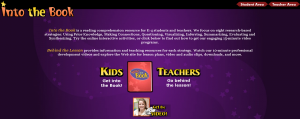 The skill of inferring is closely related in the fields of science and literacy. As a reading strategy, inferring requires readers to use prior knowledge and the information stated in a text to draw conclusions. The web site Into the Book explains that when readers infer, they “think about and search the text, and sometimes use personal knowledge to construct meaning beyond what is literally stated.”
The skill of inferring is closely related in the fields of science and literacy. As a reading strategy, inferring requires readers to use prior knowledge and the information stated in a text to draw conclusions. The web site Into the Book explains that when readers infer, they “think about and search the text, and sometimes use personal knowledge to construct meaning beyond what is literally stated.”
While inferring can be difficult for students, it is often necessary to understand the full meaning of a text. As with other reading comprehension strategies, students need explicit instruction in how to make inferences and when to apply the strategy. Teachers can support students as they develop proficiency with this skill through think-alouds, discussion of wordless picture books, and activities like charades.
In the science classroom, inferring is one of six basic science process skills identified by Michael Padilla (1990). Padilla describes inferring as “making an ‘educated guess’ about an object or event based on previously gathered data or information.” This is quite similar to the thought processes required while inferring about text, with the exception that the information used is from an object or event in the natural world, rather than a written document. Science education research demonstrates that teaching basic process skills such as inferring increases the level of student performance. Teachers can support students as they practice inferring through think-alouds, T-charts that link claims to evidence, and class discussion.
Whether you are teaching inferring as a reading comprehension strategy or science process skill, it is important to ensure that students have sufficient background knowledge of the concepts being addressed. In both reading and science, students combine personal knowledge with evidence (from the text or from an object or event) to generate inferences. Students lacking this background knowledge will struggle to make inferences, so taking the time to provide experiences that build sufficient knowledge is critical.
It is also important to ask students to explain the thought processes used to generate inferences. Questions such as How do you know that?, How does the text support your statement?, and How does the data support your explanation? help students link their claims back to concrete evidence.
Teachers can also help their students begin to differentiate between observations and inferences. Observations constitute concrete evidence or data while inferences are interpretation of that evidence or data. Scientists often interpret data in diverse ways, and readers can generate a variety of inferences from the same text. Allow time for students to share, discuss, and even debate inferences.
Finally, teachers should consider drawing student attention to the similarities between making inferences while reading and in science class. Students who see the parallels between the disciplines will be more likely to successfully apply the strategy across a diverse range of situations.
For More Information
Making Inferences
This page from the Ohio Resource Center’s Literacy K-5 collection provides an overview of inferring as well as activities that support students in using this strategy.
Into the Book: Inferring
A multimedia site that includes videos, lesson plans, and student activities for inferring and seven other reading comprehension strategies.
Learning to Observe and Infer
This article from the NSTA journal Science and Children explains how teachers can support the development of inferring and observing skills in the elementary classroom.
Reference
Padilla, M. 1990. The Science Process Skills. Research Matters – to the Science Teacher No. 9004. Retrieved from http://www.narst.org/publications/research/skill.cfm.
This article was written by Jessica Fries-Gaither. Jessica is an education resource specialist at The Ohio State University and project director of Beyond Penguins and Polar Bears. She has taught in elementary and middle school settings. Email Jessica at beyondweather@msteacher.org.
Copyright May 2011 – The Ohio State University. This material is based upon work supported by the National Science Foundation under Grant No. 1034922. Any opinions, findings, and conclusions or recommendations expressed in this material are those of the author(s) and do not necessarily reflect the views of the National Science Foundation. This work is licensed under an Attribution-ShareAlike 3.0 Unported Creative Commons license.




